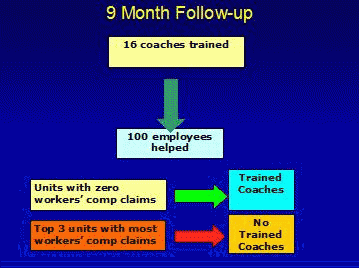The efficacy of this training program was investigated independently through a nine month telephone follow-up by the department of risk management. Peper, Gibney & Wilson (2005) showed that the 16 coaches who were interviewed had trained more than 100 employees and that departments that had no workers' compensation claims (medical claims) had coaches in their units. Most importantly, the three departments that had the most technostress as measured by the most workers' compensation claims had no trained coaches in their units as shown in Figure 6.
Figure 6. Efficacy of training employees as healthy computing coaches.
Discussion
A decrease in symptoms and improvement in positive work habits resulted from participating in the technohealth intervention are very encouraging. Ongoing informal feedback from the members of the Technohealth Experimental Group suggests that participating in the program was, and continues to be, beneficial. A recent two year follow-up showed that the participants continue to report benefits from the technohealth intervention training program as compared to the control group. For example, "Very useful' was the most common rating of the biofeedback demonstrations of the physiological response patterns during data entry at the computer. These technohealth biofeedback demonstrations of health computing helped change the participants' beliefs about the mind-body connection/relationship as well as what they could do to enhance their own health.
The use of SEMG monitoring devices while working at a computer allowed the participants to see and hear any covert increase in muscle tensions related to computer use. Participants appeared to use the biofeedback of the SEMG equipment to encourage mastery of neck and shoulders relaxation, enhance slower breathing and, facilitate taking micro-breaks while working at the computer. It is logical to attribute the self-reported reduction in body symptoms to: a) learning greater self-awareness after training with the SEMG equipment; as well as to, b) taking more breaks during each workday. The group meetings and discussions appeared to encourage homework practices, increased motivation to continue to practice, provided social support, and skills to reduce stress. Many participants reported that coaching other co-workers enhanced their own commitment to practicing healthy computing as well as improved work style.
During the group discussions, most participants reported that breathing was a "very helpful' strategy for managing stress. As one participant stated, "The breathing break has improved my ability to pace myself while completing my tasks." Many participants reported having more energy at the end of the day. This is noteworthy in that prior to this intervention, they assumed that feeling tired and a little sore at the end of the day was normal. The participants reported that the following parts of the six-week intervention were "most useful':
1) Visual feedback of the covert muscle bracing patterns and then the ability to relax the neck and shoulders--it made them believe in the training program
2) Practicing slower and lower breathing during computer work;
3) Taking micro-, meso- and macro- breaks throughout the day
4) Using ergonomic and work-style changes




